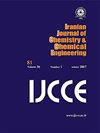Decolourization of Disperse Blue 3 Dye by Electro coagulation process using Al and Fe electrodes –Application of the Artificial Neural Network Model
IF 1.3
4区 工程技术
Q4 CHEMISTRY, MULTIDISCIPLINARY
Iranian Journal of Chemistry & Chemical Engineering-international English Edition
Pub Date : 2021-07-07
DOI:10.30492/IJCCE.2021.122812.4018
引用次数: 0
Abstract
Contamination in wastewater is a major issue in the present world, the Disperse blue 3 dye (DB3) removal was studied by an electro coagulation process using Al and Fe electrodes. The experiments were performed with synthetic solutions in batch mode. The effect of the operating parameters like the electrolysis time, current density, initial pH, conductivity, inter-electrode distance and initial dye concentration, has been investigated. The results show high discoloration efficiency, reaching 98 and 96% with Al and Fe electrodes respectively. At the optimum condition of the EC process were electrolysis times of 70 and 30 min, current densities of 139 and 93 mA/cm², initial pH 5, conductivity of 5.67 mS/cm and inter-electrode distance of 1.5 cm. The Artificial Neural Network (ANN) technique was used to model the experimental data of the current density. The feed-forward neural network model was optimized by using the Levenberg-Marquardt algorithms. A comparison between the predicted and experimental data gave high correlation coefficients (0.99977 and 1) with the minimum MSE value (1.55.10-7 and 1.31.10-5) respectively for Al and Fe electrodes.Al和Fe电极电凝法脱色分散蓝3染料——人工神经网络模型的应用
废水中的污染是目前世界上的一个主要问题,采用铝和铁电极电絮凝法对分散蓝3染料(DB3)进行了去除研究。实验是用合成溶液在批处理模式下进行的。考察了电解时间、电流密度、初始pH、电导率、电极间距离和初始染料浓度等操作参数对电解效果的影响。结果表明,铝电极和铁电极的脱色效率分别达到98%和96%。电解过程的最佳条件为电解时间70 min和30 min,电流密度139 mA/cm²和93 mA/cm²,初始pH 5,电导率5.67 mS/cm,电极间距离1.5 cm。采用人工神经网络(ANN)技术对电流密度实验数据进行建模。采用Levenberg-Marquardt算法对前馈神经网络模型进行优化。预测值与实验值的比较表明,Al和Fe电极的相关系数分别为0.99977和1,最小的均方误差分别为1.55.10-7和1.31.10-5。
本文章由计算机程序翻译,如有差异,请以英文原文为准。
求助全文
约1分钟内获得全文
求助全文
来源期刊

Iranian Journal of Chemistry & Chemical Engineering-international English Edition
CHEMISTRY, MULTIDISCIPLINARY-ENGINEERING, CHEMICAL
CiteScore
2.80
自引率
22.20%
发文量
0
审稿时长
6-12 weeks
期刊介绍:
The aim of the Iranian Journal of Chemistry and Chemical Engineering is to foster the growth of educational, scientific and Industrial Research activities among chemists and chemical engineers and to provide a medium for mutual communication and relations between Iranian academia and the industry on the one hand, and the world the scientific community on the other.
 求助内容:
求助内容: 应助结果提醒方式:
应助结果提醒方式:


